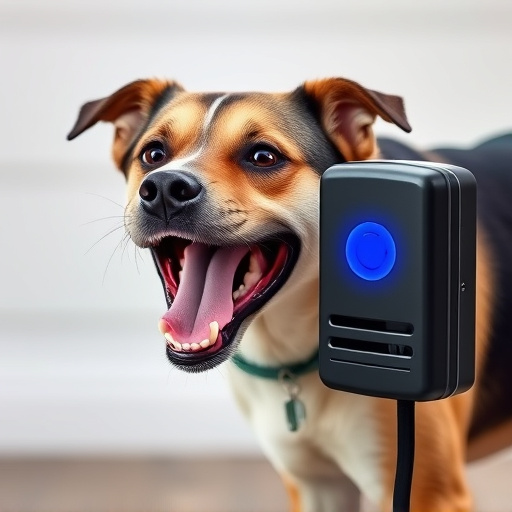Sonic dog training is a humane, innovative behavioral correction method that uses safe power levels of high-frequency sound waves to communicate with dogs without causing discomfort. Effective for issues like jumping, barking, and leash pulling, it employs positive reinforcement through subtle auditory cues, fostering a strong bond between pet and owner while teaching essential commands. Prioritizing safe power levels is crucial; adjustable sonic deterrents tailored to each dog's sensitivity ensure effective training while promoting positive learning environments and canine well-being. This approach emphasizes shaping positive behavior through immediate rewards and gentle deterrents, avoiding punishment that can induce fear or anxiety.
Discover the revolutionary power of sonic dog training, a non-physical behavioral correction method that’s gaining popularity among pet owners. This article explores how sound can be harnessed as a safe and effective dog deterrent, delving into techniques that shape positive behavior without resorting to force. We’ll discuss the science behind it, explore case studies, and provide best practices for implementing this game-changing approach, focusing on maintaining Safe Power Levels for your canine companion’s well-being.
- Understanding Sonic Dog Training: A Non-Physical Approach
- Safe Power Levels: Ensuring Well-Being and Effective Training
- Behavioral Correction Techniques: Shaping Positive Behavior
- The Role of Sound as a Dog Deterrent: Case Studies and Best Practices
Understanding Sonic Dog Training: A Non-Physical Approach
Sonic dog training is a revolutionary behavioral correction method that utilizes safe power levels to train and deter dogs without resorting to physical force. Unlike traditional punishment-based training, this approach leverages high-frequency sound waves to communicate with canines. By emitting sounds at specific frequencies, sonic trainers can gently guide dogs away from unwanted behaviors or locations. The technology operates on the principle of positive reinforcement, encouraging desirable actions through subtle auditory cues.
This method is particularly effective for addressing issues like jumping, barking excessively, or pulling on leashes. It’s a safe dog deterrent that operates at levels below human hearing, ensuring no discomfort or harm to your pet. This non-physical training technique promotes a strong bond between you and your canine companion while teaching them essential commands and boundaries.
Safe Power Levels: Ensuring Well-Being and Effective Training
When employing sonic dog training and behavioral correction methods, it’s paramount to prioritize safe power levels. Using excessive sound pressure can cause hearing damage or distress in dogs, undermining the training process and animal welfare. Effective and responsible trainers understand that subtle, precisely targeted sounds are far more successful and humane.
Adjustable sonic deterrents designed for dog training allow users to set safe power levels tailored to each dog’s sensitivity. This ensures that training remains effective while minimizing potential harm. By respecting a dog’s well-being, these tools promote positive learning environments and strengthen the bond between trainer and canine companion.
Behavioral Correction Techniques: Shaping Positive Behavior
Behavioral correction in dog training is an art that involves shaping and reinforcing positive behavior while gently deterring unwanted actions. Instead of punishment, which can create fear or anxiety, positive reinforcement techniques focus on encouraging desirable behaviors using safe power levels. This approach ensures a harmonious relationship between dogs and their owners without resorting to harsh methods.
Shaping positive behavior begins with understanding your dog’s motivations and preferences. By rewarding desired actions immediately after they occur, you teach your dog what is expected of them. For instance, if you want to correct excessive barking, you can wait for a moment of calmness, then immediately reward your dog when they remain quiet. Over time, this technique teaches the dog that remaining quiet brings positive consequences. Using safe power levels means being consistent and patient, allowing the dog to learn at their own pace without overwhelming them.
The Role of Sound as a Dog Deterrent: Case Studies and Best Practices
Sound, when used at safe power levels, can be a highly effective dog deterrent and behavioral correction tool. The role of acoustic signals in canine communication is profound; dogs have an acute sense of hearing, allowing them to perceive sounds that humans often miss. By leveraging this sensory advantage, trainers can implement specific auditory cues to manage and redirect unwanted behaviors. Case studies have shown that positive reinforcement techniques, coupled with precisely targeted sound stimuli, can be incredibly successful in modifying dog behavior without resorting to harsh methods.
In practice, this involves training dogs to associate certain sounds with desired actions or outcomes. For instance, a high-pitched whistle or a specific tone from a clicker can signal ‘stop’ or ‘no’. When the dog responds appropriately, a treat follows, reinforcing the desired behavior. This method is particularly useful in situations where visual cues might not be effective due to distance or the dog’s focus on a particular task. Best practices dictate that trainers should start at low power levels and gradually increase the intensity of sounds, ensuring they remain within safe limits to avoid any potential harm to the dog’s hearing.
Sonic dog training offers a humane and effective approach to behavioral correction, leveraging sound as a powerful tool without resorting to physical punishment. By understanding safe power levels and employing techniques like shaping positive behavior, owners can harness the potential of this method to create well-behaved pets. The role of sound as a dog deterrent is evident in various case studies, demonstrating its effectiveness when used responsibly and ethically. Incorporating these practices into your training regimen promotes a healthier, happier bond between you and your canine companion while ensuring their overall well-being.
